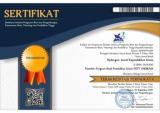Analysis of Protein Content in Moringa Leaves (Moringa oleifera) and Katuk (Sauropus androgynus) as an Alternative Plant-Based Protein
Abstract
Indonesia has many extraordinary biological resources, including flora that have great potential to function as a source of vegetable protein, such as Moringa oleifera and Sauropus androgynus. Humans need protein because it is a macromolecule that does many things for life systems, and is needed for tissue replacement and energy supply. Protein functions as a catalyst, transports molecules such as oxygen, supports the immune system, and transmits nerve impulses. The focus of this study was the protein content in moringa leaves (Moringa oleifera) and katuk leaves (Sauropus androgynus) in the shoots, young, and old parts. The moringa leaf samples examined showed a protein content of 22.24% in the shoots, 2.992% in the young leaves, and 4.272% in the old leaves. Meanwhile, fresh katuk leaves showed a protein content of 3.898% for the shoots, 4.767% for the young leaves, and 5.127% for the old leaves. The method used was the Kjeldahl method, namely the process of destruction, distillation, and titration used to measure protein content. The results of the study showed that moringa leaves, especially the shoots, have a higher protein content compared to katuk leaves, indicating that moringa leaves can function as an important source of vegetable protein. This study aims to measure and compare the protein levels in the top, young and old leaves of the two plants in fresh condition, in order to provide a more accurate picture of the nutritional potential of each part of the leaf and its contribution to the diversification of vegetable protein sources.
Keywords
Full Text:
PDFReferences
Anju, T., Rai, N. K. S. R., & Kumar, A. (2022). Sauropus androgynus (L.) Merr.: a multipurpose plant with multiple uses in traditional ethnic culinary and ethnomedicinal preparations. Journal of Ethnic Food, 9(10), 1-29.
Arsa, S., Rahmatan, H., Safrida., Djufri., & Marisa. (2024). Meningkatkan profuktivitas ASI ibu menyusui di gampong barabung dan gampong tungkop dengan peranan sayur daun katuk. Jurnal Ilmiah Mahasiswa Pendidikan Biologi FKIP USK, 9(1), 116-126.
Devi, P. A. S., Sari, P. M. N. A., Pangesti, N. M. D. P., & Pratiwi, N. K. A. S. (2023). Potensi daun kelor (Moringa oleifera L.) pada olahan makanan populer sebagai antioksidan untuk meningkatkan nilai gizi. Prosiding Workshop dan Seminar Nasional Farmasi, 2(1), 464–482.
Gomes, S. M., Leitão, A., Alves, A., & Santos, L. (2023). Incorporation of moringa oleifera leaf extract in yoghurts to mitigate children’s malnutrition in developing countries. Molecules, 28(6), 2526.
Guzmán-Maldonado, S. H., López-Manzano, M. J., Madera-Santana, T. J., Núñez-Colín, C. A., Grijalva-Verdugo, C. P., Villa-Lerma, A. G., & Rodríguez-Núñe, J. R. (2020). Nutritional characterization of moringa oleifera leaves, seeds, husks and flowers from two regions of mexico. Agronomía Colombiana, 38(2), 287–297.
Irwan., & Irwan, Z. (2020). Kandungan zat gizi daun kelor (Moringa oleifera) berdasarkan metode pengeringan. Jurnal Kesehatan Manarang, 6(1), 69–77.
Islam, Z., Islam, S. M. R., Hossen, F., Mahtab-Ul-Islam, K., Hasan, R., & Karim, R. (2021). Moringa oleifera is a prominent source of nutrients with potential health benefits. Int. J. Food Sci, 23(1), 1497-1556.
Laka, M., & Wangge, E. S. A. (2018). Uji kandungan protein pada beberapa varietas umbi ubi kayu (Manihot esculenta crantz) yang dihasilkan di desa randotonda, kecamatan ende, kabupaten ende. Jurnal Agrica, 11(1), 43–50.
Marhaeni, L. S. (2022). Daun kelor (Moringa oleifera) sebagai sumber pangan fungsional dan antioksidan. Agrisia: Jurnal Ilmu-ilmu Pertanian, 13(2), 40–53.
Mulyati, S., Nurhidayat, A. I., Faturrochman, F. F. F., Dzaqiah, M. N., & Rendra, E. (2024). Potensi daun katuk (Saoropus androggynus) sebagai sayuran superfood. Jurnal Multidisplin Ilmu Akademik, 1(6), 300–306.
Nofiyanto, E., & Cahyanti, A. N. (2023). Pengaruh penambahan daun kelor (Moringa oleifera) dan ubi jalar ungu (Ipomoea batatas l) terhadap karakteristik kimia dan organoleptik makanan pendamping asi (mp-asi). Jurnal Sains dan Teknologi Pangan, 8(5), 6577–6591.
Paramita, V. D., HR, Y., Rosalin., & Purnama, I. (2021). Pengaruh berbagai metode pengeringan terhadap kadar air, abu, dan protein dalam tepung daun kelor. Prosiding 5th Seminar Nasional Penelitian & Pengabdian Kepada Masyarakat (pp. 21-26). Pontianak, Indonesia: Dapertemen Agrosains, Universitas Panca Bhakti.
Petrus, A. J. A. (2013). Sauropus androgynus (l.) Merrill-a potentially nutritive functional leafy-vegetable. Asian Journal of Chemistry, 25(17), 9425–9433.
Putriani, K., Harmida., & Juswardi. (2022). Perbedaan dan kelimpahan metabolit daun kelor (Moringa oleifera lam.) berdasarkan ketinggian tempat di sumatera selatan. Prosiding Seminar Nasional Pendidikan Biologi dan Saintek (pp. 205–212. Surakarta, Indonesia: Pendidikan Biologi dan Saintek, Universitas Muhammadiyah Surakarta.
Salsabila, A., Agustin, R., & Budiati, T. (2022). Pengaruh penambahan tepung daun katuk terhadap kualitas organoleptik dan fisik roti tawar. Journal of Food Engineering, 1(2), 66–79.
Saputri, G. R., Tutik., & Permatasari, A. I. (2019). Determination of protein levels in young and old leaves (Moringa oleifera L.) leaves using the kjeldahl method. Jurnal Analis Farmasi, 4(2), 108–116.
Sari, R. A., Prabowo, S., & hidayati, N. (2021). Analisis kandungan protein daun kelor (moringa oleifera) berdasarkan usia daun. Jurnal Ilmu Pertanian, 8(2), 45–52.
Sartika, D., Marjanah., & Mawardi. (2019). Effect of katuk leaves (sauropus androgynus) on the growth domestic ducks (anas platyrhynchos). Jurnal Jeumpa, 6(1), 172–176.
Senas, P. (2023). Efektivitas penambahan daun katuk (Saoropus androggynus) terhadap otak-otak ikan bandeng (Chanos chanos). Jurnal Pengolahan Hasil Perikanan Indonesia (JPHPI), 26(1), 164–176.
Sukarini, N. E., Sukaryani, S., & Widharto. (2023). Studi pemanfaatan tepung daun indigofera (indigofera zollingeriana) sebagai substitusi pakan terhadap performan produksi dan kualitas telur ayam petelur. Jurnal Ilmu-Ilmu Pertanian, 7(2), 110–118.
Sulistiani, R., Saragih, S. A., Munar, A., & Pohan, B. B. P. (2023). Peningkatan produksi daun dan kadar protein kelor (moringa oleifera) dengan aplikasi pupuk organik pada lahan spesifik lokasi. Agrovital: Jurnal Ilmu Pertanian, 8(1), 39–47.
DOI: https://doi.org/10.33394/hjkk.v13i3.16430
Refbacks
- There are currently no refbacks.

This work is licensed under a Creative Commons Attribution-ShareAlike 4.0 International License.





